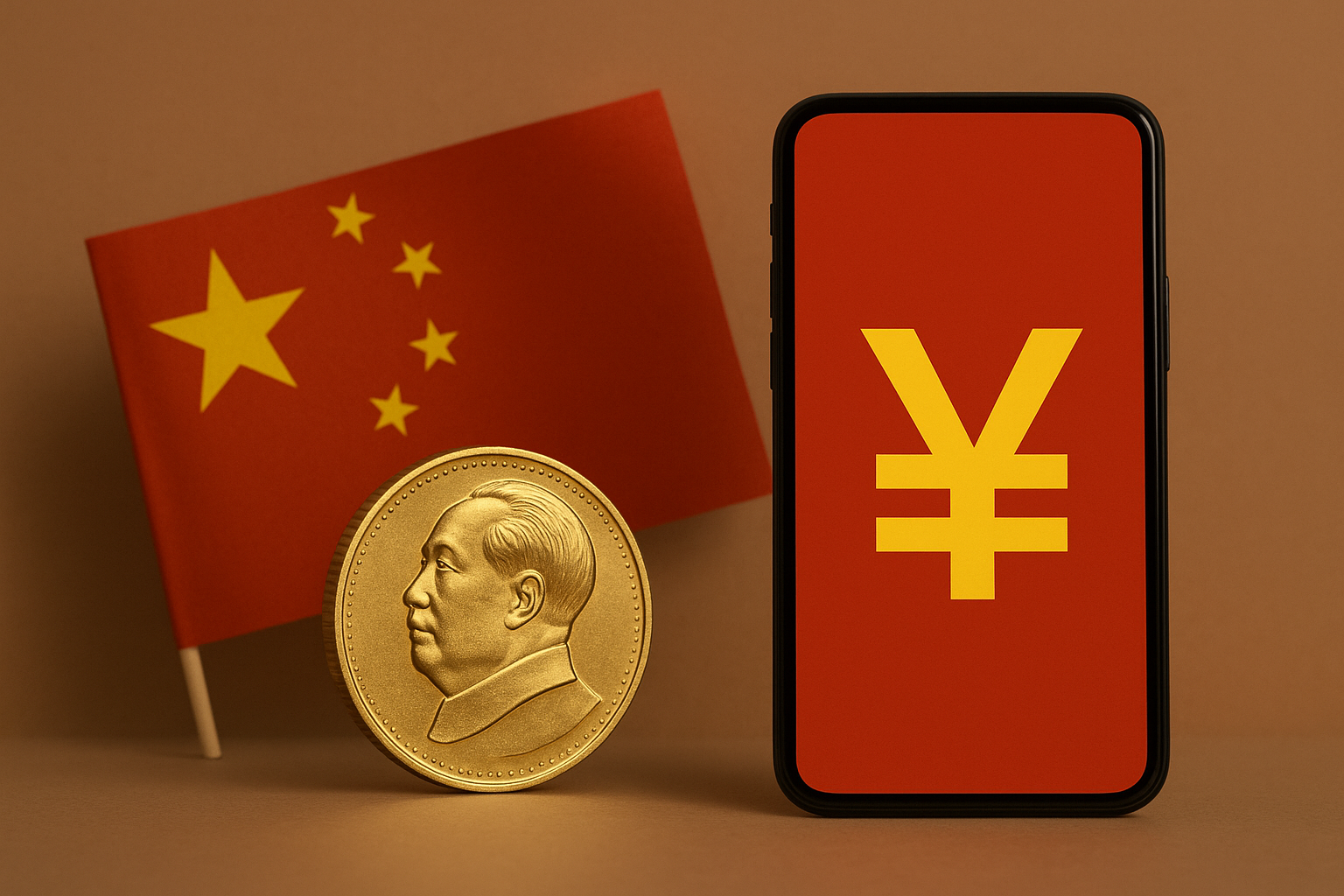Blockchain Technology
China Considers Yuan Backed Stablecoins To Boost Global Currency Usage

Introduction
China is at a crucial crossroads in its economic and financial strategy. For decades, the country has sought to elevate the renminbi, commonly referred to as the yuan, as a global reserve currency that could rival the United States dollar. Now, reports indicate that Beijing is considering the issuance of yuan backed stablecoins, a decision that would mark a dramatic shift in its approach to digital assets. This potential change comes after years of strict crackdowns on cryptocurrency activity within its borders, including the 2021 ban on cryptocurrency trading and mining. Stablecoins backed by the yuan could offer Beijing a controlled yet innovative tool to promote international usage of its currency, while maintaining tight oversight of capital flows.
A Policy Shift Of Global Significance
The possibility of yuan backed stablecoins signals a significant reversal from China’s earlier hostile stance toward digital currencies. Stablecoins are digital tokens pegged to a fiat currency such as the dollar or euro and designed to maintain price stability. For Beijing, creating a state supervised yuan stablecoin could serve as a bridge between blockchain based finance and the internationalisation of its national currency. While the ban on cryptocurrencies was justified on grounds of financial stability, energy consumption, and speculative excess, stablecoins tied to the yuan provide a different narrative: they could be harnessed as tools of state policy, embedded within regulatory frameworks, and designed to support global trade.
The Strategic Drivers Behind Yuan Stablecoins
Challenging the Dollar’s Dominance
At the heart of China’s interest in stablecoins lies the ambition to challenge the overwhelming dominance of the United States dollar in international finance. Nearly half of global transactions are denominated in dollars, while the yuan represents only a small fraction. For Beijing, this imbalance is not merely an economic issue but also a geopolitical one. Dependence on the dollar exposes China to U.S. financial sanctions and restricts its ability to wield independent influence in global markets. A yuan backed stablecoin could provide an alternative payment method for countries and corporations seeking to diversify away from dollar reliance, particularly in Asia, Africa, and regions engaged in China’s Belt and Road Initiative.
Controlled Embrace of Blockchain
While decentralised cryptocurrencies run counter to China’s philosophy of state control, blockchain technology itself is seen as a tool to enhance efficiency and oversight. A yuan stablecoin would almost certainly be issued and managed under a permissioned framework, allowing regulators to monitor flows, enforce capital controls, and even program specific rules into transactions. Features such as geofencing or time limited use could be embedded to ensure that stablecoins function within policy boundaries. This controlled embrace allows China to leverage the advantages of blockchain while avoiding the risks of an open, uncontrolled financial system.
Pilots in Hong Kong and Shanghai
Initial deployment of yuan backed stablecoins is expected to take place in financial hubs such as Hong Kong and Shanghai. Hong Kong already possesses a well developed regulatory structure for digital assets and has introduced licensing regimes for stablecoin issuers. This makes it a natural laboratory for experimentation. Shanghai, as a mainland hub, could provide a tightly controlled environment for domestic trials. By starting in select financial centers, China can gradually expand use cases while minimizing risks of capital flight or speculative misuse.
Blueprint For Implementation
Roadmap and Governance
China’s policy roadmap for yuan backed stablecoins is expected to include concrete usage targets, defined regulatory responsibilities, and detailed mechanisms for risk prevention. Central agencies such as the People’s Bank of China, the Ministry of Finance, and financial regulators would play central roles. Governance would likely involve a tiered oversight model, with commercial banks and select technology firms participating in issuance under state approval.
Oversight and Risk Management
Risk management will be paramount. Authorities are expected to impose strict protocols on issuance, circulation, and redemption of stablecoins. The goal is to ensure that the system promotes international usage of the yuan without destabilizing domestic financial markets. Former senior officials have already urged caution, warning that stablecoins could quickly become instruments of speculation if not carefully regulated.
Hong Kong as a Testing Ground
Hong Kong’s regulatory regime provides a strong starting point for the initiative. The city’s licensing system for stablecoin issuers requires strict capital requirements, custody arrangements, and audit procedures. This framework ensures that only highly capitalized and reputable firms can participate. By initially focusing on business to business transactions such as cross border settlements and interbank transfers, China can gather valuable data before allowing broader consumer adoption.
Challenges And Constraints
Capital Controls
One of the most significant barriers to internationalisation of the yuan is China’s stringent capital controls. While stablecoins could make yuan transfers more efficient, restrictions on convertibility remain a major hurdle. Unless Beijing loosens capital flow regulations, global adoption of a yuan stablecoin may be limited.
Limited Convertibility of the Yuan
Unlike the U.S. dollar or the euro, the yuan is not fully convertible in offshore markets. Investors and corporations may be reluctant to hold yuan denominated assets, even in stablecoin form, if they cannot easily exchange them for other currencies. This limitation could restrict the appeal of yuan stablecoins outside of China’s immediate trading partners.
Entrenched Dominance of Dollar Stablecoins
Stablecoins pegged to the U.S. dollar already dominate global crypto and digital payment markets. Tokens such as USDT and USDC are deeply entrenched, with billions in daily transaction volume. Competing against these established instruments will require China not only to build technical infrastructure but also to cultivate international trust in its financial system.
Economic And Market Impact
Stock Market Response
The announcement of potential yuan backed stablecoins has already had ripple effects across China’s financial markets. Fintech companies and firms with exposure to blockchain based finance saw their shares surge, and stock indices in Shanghai reached decade highs on speculation of policy support.
Trade and Remittance Benefits
Yuan stablecoins could significantly reduce the cost and complexity of cross border trade and remittances. Businesses engaged in trade with China would benefit from faster settlement times and lower reliance on the U.S. dominated Swift system. For individuals, stablecoins could simplify remittances to and from China, particularly for workers and families in Southeast Asia and Africa.
Boost for Technology Giants
Large technology firms such as JD.com and Ant Group are expected to play a central role in stablecoin implementation. These companies already manage vast digital payment networks and could integrate yuan stablecoins into existing platforms. Their participation would expand the reach of stablecoins across e-commerce, logistics, and financial services.
Global And Geopolitical Implications
Challenging U.S. Financial Architecture
The launch of a yuan backed stablecoin would present a direct challenge to U.S. financial influence. By providing countries with an alternative payment infrastructure, China could reduce global reliance on dollar dominated systems. This is particularly significant in regions facing U.S. sanctions, where access to dollar clearing systems is restricted.
Regional Currency Competition
China is not alone in exploring stablecoins. Japan is preparing its own yen backed stablecoin, while South Korea and Singapore are advancing their digital currency projects. A regional competition is unfolding in Asia, with each country seeking to shape the future of digital payments.
Regulatory Momentum Worldwide
China’s move will add urgency to global regulatory debates about stablecoins. The United States has already introduced legislation to regulate stablecoins, while Europe is advancing its digital euro project. China’s participation signals that stablecoins are becoming a mainstream financial instrument, forcing governments to develop robust frameworks for their oversight.
Looking Ahead
In the near term, several key developments are expected. The Chinese State Council is anticipated to finalize its policy roadmap, which will provide clarity on issuance models and regulatory structures. Pilot projects in Hong Kong are likely to emerge first, with licensed institutions testing yuan stablecoins in limited business to business transactions. Over time, the mainland may expand usage to specific trade corridors or financial institutions, while continuing to enforce strict guardrails on capital flows.
Technology infrastructure will also evolve. Expect the development of permissioned blockchain systems designed to embed regulatory controls directly into the architecture. Features such as transaction caps, real time reporting, and programmable restrictions will be built to maintain policy compliance.
The reaction of international markets will be closely watched. Some countries may welcome a yuan stablecoin as a diversification tool, while others may see it as a geopolitical maneuver. Regardless of perception, China’s move is set to accelerate the global race to define the future of digital currencies.
Conclusion
China’s exploration of yuan backed stablecoins marks a turning point in the evolution of both its domestic financial policy and the global digital economy. By embracing blockchain under strict supervision, Beijing seeks to balance innovation with control, using technology to extend the international reach of the yuan while maintaining capital restrictions. The initiative reflects China’s long term ambition to challenge dollar dominance, enhance trade efficiency, and position itself as a leader in digital finance.
While obstacles remain, including limited convertibility and entrenched reliance on dollar stablecoins, the introduction of yuan backed stablecoins has the potential to reshape the global financial order. It represents not only a technological experiment but also a geopolitical statement, underscoring China’s determination to redefine its place in the international monetary system.











